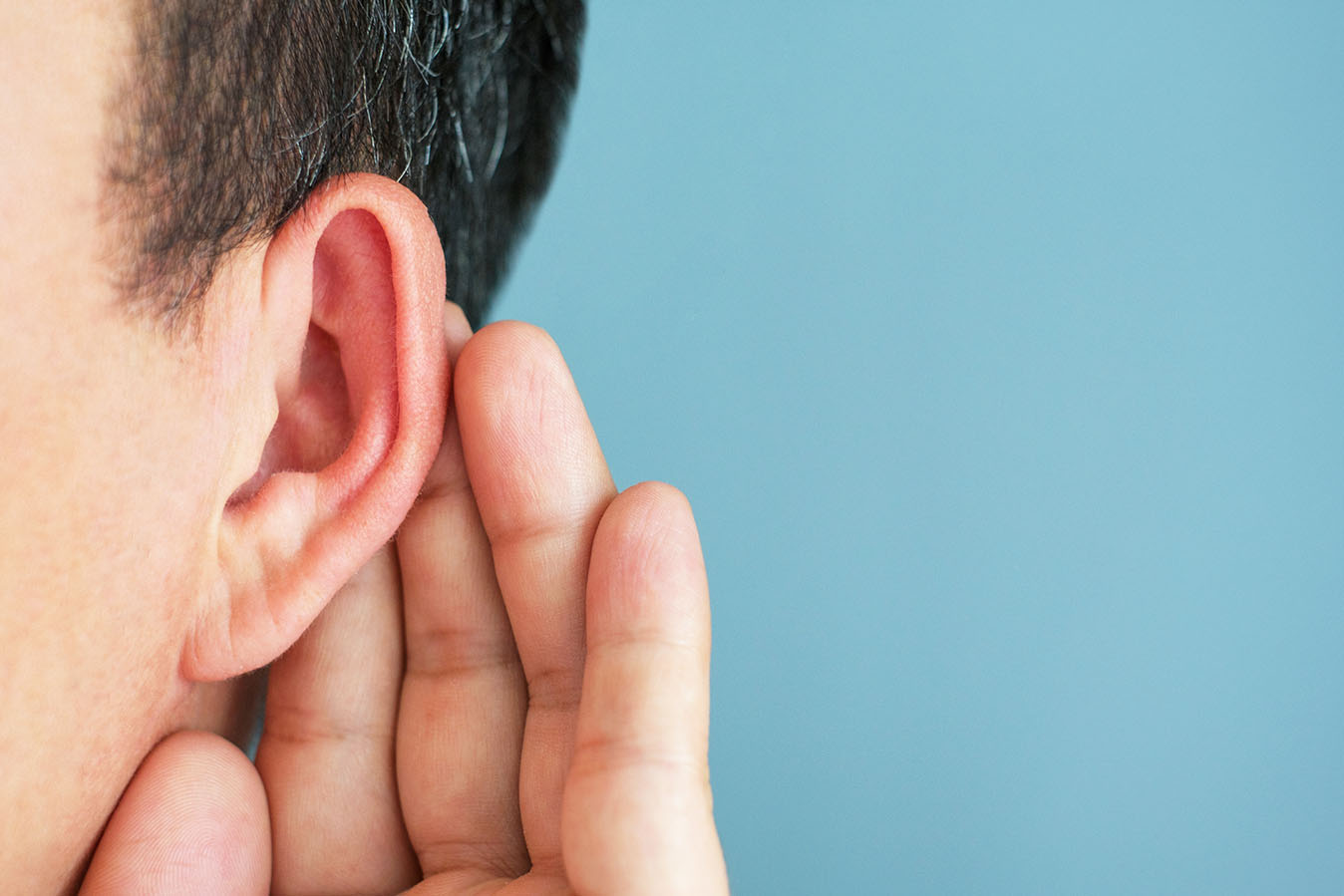With another wave of COVID-19 infections building and a peak expected around Christmas 2023, the pandemic is now having a double impact on both people with new acute infections as well as on people suffering with a variety of post-COVID-19 conditions.
Among these, there are increasing reports of Sudden Sensorineural Hearing Loss (SSNHL) and other auditory disturbances arising following acute COVID-19 infection.1-3
SSNHL is the rapid loss of hearing of 30 decibels (dB) or greater over less than 72 hours.4 This hearing loss is generally idiopathic (arising spontaneously with no clear cause) and unilateral (affecting only one ear).5-7 Sensorineural hearing loss is a result of damage to the inner ear, as opposed to conductive hearing loss, which is a result of damage to the middle or outer ear.8 SSNHL is often accompanied by a range of comorbid symptoms including a feeling of ear ‘fulness’, vertigo, and tinnitus.5 The hearing loss may be present when first waking in the morning,9 can develop rapidly during the day,10 or suddenly appear after hearing a loud ‘pop’.5 The global incidence of SSNHL in the general population (i.e., not associated with COVID-19) is 5-27 per 100,000 people, per year.11 SSNHL is typically observed in people between the ages of 50-60, with the least affected group being those aged 20-30.12
SSNHL and COVID-19
During the early stages of the COVID-19 pandemic an increased incidence rate of SSNHL presentations was detected at a Turkish hospital, with 41 of 68 (60.3%) patients presenting with SSNHL patients also presenting with recent or current symptoms that suggested a COVID-19 infection.13 A similar trend was observed in a Chinese hospital, with a higher incidence rate of patients presenting with tinnitus or sudden deafness during the COVID-19 pandemic as compared to the same period the previous year.14 These findings, and observations by medical staff across the globe during the peak of the COVID-19 pandemic, brought to light the existence of this unexpected manifestation of COVID-19.
While at this stage, SSNHL following or during acute COVID-19 was poorly understood, the existence of a link was becoming evident. In 2021, Dusan and colleagues found that among 74 COVID-19 patients in Serbia, 30 (40.5%) experienced sensorineural type of hearing loss.15 Then in 2023, Dorobisz and colleagues found that among a cohort of 58 patients who had PCR-confirmed COVID-19 up to six months prior, 65.5% (n=38) could be diagnosed with sensorineural hearing loss.16 More modest incidence rates suggest an increase of SSNHL during the COVID-19 pandemic to be around 3.2%, compared to 0.0005%-0.16% before the pandemic, suggesting that COVID-19 may be among the causes of SSNHL.17 As viral aetiology for SSNHL has been previously observed, the assumption that COVID-19 may cause SSNHL is not solely theoretical.18
Aetiology
While the causes of SSNHL are often idiopathic,6 COVID-19-related SSNHL has been theorised to be a result of the virus affecting the cochlear hair cell functions, 19 and COVID-19 viral inflammation causing labyrinthitis or vestibular neuritis.20,21 These theories are supported by evidence of the SARS-CoV-2 virus presence in the porous areas of the mastoid bone suggesting the virus may gain access to the labyrinth compartment,22,23 and similar aetiology findings of other viral infections causing SSNHL.21,24 Some studies suggest that SSNHL may be a later developing symptom caused by postinfectious inflammation of the auditory nerve and perineural tissue.16,25 Further, as COVID-19 is known to be neurotropic, there is potential for it to affect the auditory centre in the temporal lobe,26 resulting in sudden hearing loss.27,28 More research is needed to understand the aetiology of COVID related SSNHL, however, it is evident that there is potential for auditory COVID-19 manifestations.29
Symptoms
COVID-19 related SSNHL presentations are likely to be comorbid with tinnitus, vertigo, and dizziness, with a small amount of people also experiencing peripheral nerve palsy.30 Additionally, some may experience chemosensory loss prior to hearing loss,31,32 suggesting that the loss of taste and/or smell could prodrome COVID-19-related SSNHL. Symptoms are likely to develop at between seven days to two moths post COVID-19 diagnostic,2,17 suggesting that COVID-19 related SSNHL may be a delayed symptom of COVID-19 and occur after the recovery from the acute phase, however some may developed it before the diagnosis of COVID-19.2
Diagnosis
The diagnosis of SSNHL requires ruling out conductive hearing loss.9 Sensorineural hearing loss is a result of damage to the inner ear, often to the cochlear hairs, whereas conductive hearing loss is a result of sound waves being unable to reach the inner ear, often a result of damage or blockage to the middle or external ear.8 This distinction can be made by using tuning fork evaluations, otoscopy, acumetry, tonal audiometry, speech audiometry, and tympanometry diagnostics, which can also be used to determine the extent of hearing loss.33,34 Further, a MRI can be performed to help discount specific causes of hearing loss and may help in assessing the hearing losses aetiology.34,35 If the cause of hearing loss remains unknown, practitioners are urged to consider the possibility of the link between SSNHL and COVID-19 and begin an immediate course of treatment.
Treatment
Early detection and aggressive treatment of SSNHL is required for best outcomes and to reduce risk of permanent damage.36,37 Treatments for COVID-19 SSNHL are suggested to include an immediate course of systemic steroids (e.g., Corticosteroids, Glucocorticoids).36 A high-dose of oral steroids, 38 intratympanic treatment, 2 or a combination of the two is recommended.9 The immediate use of systemic steroids may help to reduce viral inflammation in the inner ear,39 however as they are immunosuppressant risks and benefits for patients on high-dose steroids should be considered,40 especially for those with current COVID-19 infections.41 Treatment is most effective when prescribed within two weeks,42 therefore those with suspected SSNHL are urged to seek immediate medical attention.
Conclusion
Preliminary findings on the causes of SSNHL following acute COVID-19 findings suggest a neurotropic pathophysiology,27,28 with a prevalence rate of around 3.2% following acute COVID-19.17 SSNHL often presents in previous COVID-19 sufferers as sudden, mild, unilateral hearing loss, often alongside of tinnitus and vertigo. Those with any symptoms are urged to seek immediate medical attention as aggressive courses of steroids are required for best outcomes. Additionally, clinicians should consider the COVID-19 may lead to SSNHL and conduct screening where appropriate, to allow for early diagnostic and treatment.38
Clinicians and policy makers should recognise SSNHL as a possible sign of COVID-19, a complication of acute COVID-19 and Long COVID. Additionally, research supported via the Medical Research Future Fund (MRFF) into post-acute sequelae of COVID-19 (PASC) should include a focus on COVID-19-related SSNHL, its aetiology and its impact on sufferers. With the growing number of COVID-19 cases in Australia, up to date COVID-19 vaccinations remain recommended for reducing the risk and severity of COVID-19 infection, and no large-scale clinical evidence exists to suggest that the vaccination may impact upon the prevalence of SSNHL following COVID-19.43
References
-
Gibson K, Ling JCC, Peters M. Experience of sudden sensorineural hearing loss following a mild COVID-19 infection. BMJ Case Rep. 2023;16(4).
-
Meng X, Wang J, Sun J, Zhu K. COVID-19 and sudden sensorineural hearing loss: A systematic review. Front Neurol. 2022;13:883749.
-
Yaseen NK, Al-Ani RM, Ali Rashid R. COVID-19-related sudden sensorineural hearing loss. Qatar Med J. 2021;2021(3):58.
-
Foden N, Mehta N, Joseph T. Sudden onset hearing loss. Aust J Gen Pract. 2013;42:641-4.
-
National Institute on Deafness and Other Communication Disorders. NIDCD fact sheet: sudden deafness. National Institutes of Health. 2018. Available from: https://www.nidcd.nih.gov/sites/default/files/Documents/health/hearing/Sudden-Deafness.pdf
-
Kuhn M, Heman-Ackah SE, Shaikh JA, Roehm PC. Sudden sensorineural hearing loss: a review of diagnosis, treatment, and prognosis. Trends Amplif. 2011;15(3):91-105.
-
Rauch SD. Idiopathic sudden sensorineural hearing loss. N Engl J Med. 2008;359(8):833-40.
-
Tanna RJ LJ, De Jesus O. Sensorineural Hearing Loss. Treasure Island (FL): StatPearls Publishing; 2023.
-
Leung MA, Flaherty A, Zhang JA, Hara J, Barber W, Burgess L. Sudden sensorineural hearing loss: primary care update. Hawaii J Med Public Health. 2016;75(6):172-4.
-
Weber PC. Sudden sensorineural hearing loss in adults: Evaluation and management. 2022. Available from: https://www.uptodate.com/contents/sudden-sensorineural-hearing-loss-in-adults-evaluation-and-management#references.
-
Jung WW, Hoegerl C. Sudden sensorineural hearing loss and why it’s an emergency. Cureus. 2022;14(1):e21418.
-
Rizzo S, Bentivegna D, Thomas E, et al. Sudden sensorineural hearing loss, an invisible male: State of the art. Hearing Loss: Etiology, Management and Societal Implications. 2017:75-86.
-
Fidan V, Akin O, Koyuncu H. Rised sudden sensorineural hearing loss during COVID-19 widespread. Am J Otolaryngol. 2021;42(5):102996.
-
Jin L, Fan K, Tan S, Liu S, Wang Y, Yu S. Analysis of the characteristics of outpatient and emergency diseases in the department of otolaryngology during the “COVID-19” pandemic. Sci Prog. 2021;104(3):368504211036319.
-
Dusan M, Milan S, Nikola D. COVID-19 caused hearing loss. Eur Arch Otorhinolaryngol. 2022;279(5):2363-72.
-
Dorobisz K, Pazdro-Zastawny K, Misiak P, Kruk-Krzemień A, Zatoński T. sensorineural hearing loss in patients with Long-COVID-19: objective and behavioral audiometric findings. Infect Drug Resist. 2023;16:1931-9.
-
Kandakure VT, Kunjumon R, Dube Y, More MS, Garje S. A prospective study on post Covid sudden onset sensory neural hearing loss and its recovery. Indian J Otolaryngol Head Neck Surg. 2023;75(1):451-7.
-
Deewani MH, Siddiqui MI. Sudden sensorineural hearing loss after Covid-19 infection. J Pak Med Assoc. 2023;73(6):1291-3.
-
Mustafa MWM. Audiological profile of asymptomatic Covid-19 PCR-positive cases. Am J Otolaryngol. 2020; 41(3): 102483.
-
Chern A, Famuyide AO, Moonis G, Lalwani AK. bilateral sudden sensorineural hearing loss and intralabyrinthine hemorrhage in a patient with COVID-19. Otol Neurotol. 2021;42(1):e10-e4.
-
Cohen BE, Durstenfeld A, Roehm PC. Viral causes of hearing loss: a review for hearing health professionals. Trends Hear. 2014;18.
-
Frazier KM, Hooper JE, Mostafa HH, Stewart CM. SARS-CoV-2 virus isolated from the mastoid and middle ear: implications for COVID-19 precautions during ear surgery. JAMA Otolaryngol Head Neck Surg. 2020;146(10):964-6.
-
Frosolini A, Franz L, Daloiso A, de Filippis C, Marioni G. Sudden sensorineural hearing loss in the covid-19 pandemic: A systematic review and meta-analysis. Diagnostics (Basel). 2022;12(12).
-
Mateer EJ, Huang C, Shehu NY, Paessler S. Lassa fever–induced sensorineural hearing loss: A neglected public health and social burden. PLoS Negl Trop Dis. 2018;12(2):e0006187.
-
Kilic O, Kalcioglu MT, Cag Y, et al. Could sudden sensorineural hearing loss be the sole manifestation of COVID-19? An investigation into SARS-COV-2 in the etiology of sudden sensorineural hearing loss. IJID Reg. 2020;97:208-11.
-
Wong MY, Tang WS, Zakaria Z. Unilateral sudden sensorineural hearing loss in post-COVID-19 patients: Case report. Malays Fam Physician. 2022;17(2):112-6.
-
Karimi-Galougahi M, Naeini AS, Raad N, Mikaniki N, Ghorbani J. Vertigo and hearing loss during the COVID-19 pandemic – is there an association? Acta Otorhinolaryngol Ital. 2020;40(6):463-5.
-
Fraczek M, Resler K, Szetela B. Can We Expect More Patients with Hearing Loss Due to COVID-19? Hear J. 2020;73(12).
-
Chirakkal P, Al Hail AN, Zada N, Vijayakumar DS. COVID-19 and tinnitus. Ear Nose Throat J. 2021;100(2_suppl):160s-2s.
-
Meng X, Wang J, Sun J, Zhu K. COVID-19 and sudden sensorineural hearing loss: A systematic review. Front Neurol. 2022;13.
-
Shah S, Rocke J, France K, Izzat S. Sudden sensorineural hearing loss in COVID-19: A case series from the Wrightington, Wigan and Leigh Teaching Hospitals, United Kingdom. Med J Malaysia. 2021;76(Suppl 4):55-9.
-
Swain SK, Pani SR. Incidence of hearing loss in COVID-19 patients: A COVID hospital-based study in the eastern part of India. Int J Curr Res Rev. 2021;13:103-7.
-
Rauch SD. Clinical practice. Idiopathic sudden sensorineural hearing loss. N Engl J Med. 2008;359(8):833-40.
-
Herrera M, Berrocal JRG, Arumí AG, Lavilla MJ, Plaza G. Update on consensus on diagnosis and treatment of idiopathic sudden sensorineural hearing loss. Acta Otorrinolaringol Esp (Engl Ed). 2019;70(5): 90-300.
-
Conte G, Berardino FD, Sina C, et al. MR Imaging in sudden sensorineural hearing loss: Time to talk. AJNR Am J Neuroradiol. 2017;38(8):1475-9.
-
Koumpa FS, Forde CT, Manjaly JG. Sudden irreversible hearing loss post COVID-19. BMJ Case Rep. 2020;13(11):e238419.
-
Cheng Y-F, Chu Y-C, Tu T-Y, Shiao A-S, Wu S-L, Liao W-H. Modified Siegel’s criteria for sudden sensorineural hearing loss: Reporting recovery outcomes with matched pretreatment hearing grades. J Chin Med Assoc. 2018;81(11).
-
Balai E, Gupta KK, Darr A, Jindal M. Comparing the use of high dose to standard dose corticosteroids for the treatment of sudden sensorineural hearing loss in adults – A systematic review. Auris Nasus Larynx. 2023.
-
Jeong J, Choi HS. Sudden sensorineural hearing loss after COVID-19 vaccination. Int J Infect Dis. 2021;113:341-3.
-
Nadel DM. The Use of Systemic Steroids in Otolaryngology. Ear Nose Throat J. 1996;75(8):502-16.
-
Berton AM, Prencipe N, Giordano R, Ghigo E, Grottoli S. Systemic steroids in patients with COVID-19: pros and contras, an endocrinological point of view. J Endocrinol Invest. 2021;44(4):873-5.
-
Chandrasekhar SS, Tsai Do BS, Schwartz SR, et al. Clinical practice guideline: sudden hearing loss (update). Otolaryngol Head Neck Surg. 2019;161(1_suppl):S1-S45.
-
Formeister EJ, Wu MJ, Chari DA, et al. Assessment of sudden sensorineural hearing loss after COVID-19 vaccination. JAMA Otolaryngol Head Neck Surg. 2022;148(4):307-15.
Authors:
Jarrod Clarke and Dr Micah DJ Peters are also based in the Rosemary Bryant AO Research Centre, Clinical and Health Sciences, University of South Australia. Jarrod and Micah are also from the Australian Nursing and Midwifery Federation’s (ANMF) National Policy Research Unit (Federal Office). Micah holds adjunct appointments at the University of Adelaide with Health Evidence Synthesis, Recommendations and Impact (HESRI) in the School of Public Health and the School of Nursing, Health and Medical Sciences.
Kim Gibson is a registered nurse and lecturer based in the Rosemary Bryant AO Research Centre, Clinical and Health Sciences, University of South Australia.








